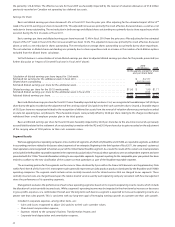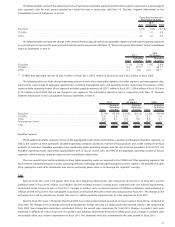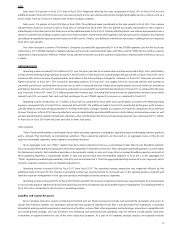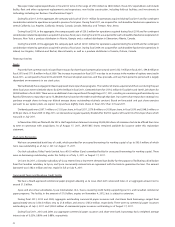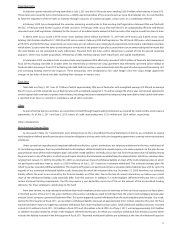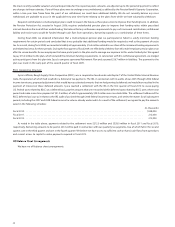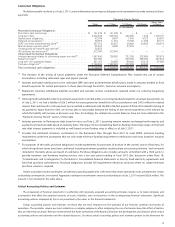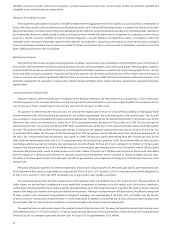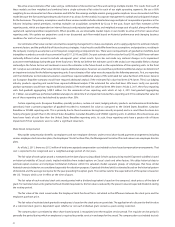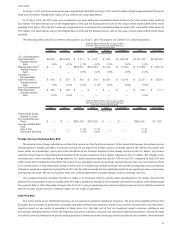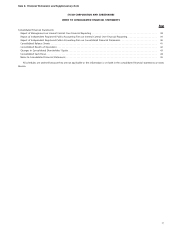Sysco 2011 Annual Report Download - page 51
Download and view the complete annual report
Please find page 51 of the 2011 Sysco annual report below. You can navigate through the pages in the report by either clicking on the pages listed below, or by using the keyword search tool below to find specific information within the annual report.
Fixed Rate Debt
Included in current maturities of long-term debt as July 2, 2011 are the 6.10% senior notes totaling $200.0 million, which mature in June 2012.
These notes were issued by Sysco International, Co., a wholly-owned subsidiary of Sysco now known as Sysco International, ULC. It is our intention
to fund the repayment of these notes at maturity through issuances of commercial paper, senior notes or a combination thereof.
In February 2009, Sysco deregistered the securities remaining unsold under its then existing shelf registration statement that was filed with
the SEC in February 2008 for the issuance of debt securities. In February 2009, Sysco filed with the SEC an automatically effective well-known
seasoned issuer shelf registration statement for the issuance of an indeterminate amount of debt securities that may be issued from time to time.
In March 2009, Sysco issued 5.375% senior notes totaling $250.0 million due March 17, 2019 (the 2019 notes) and 6.625% senior notes
totaling $250.0 million due March 17, 2039 (the 2039 notes) under its February 2009 shelf registration. The 2019 and 2039 notes, which were priced
at 99.321% and 98.061% of par, respectively, are unsecured, are not subject to any sinking fund requirement and include a redemption provision
which allows Sysco to retire the notes at any time prior to maturity at the greater of par plus accrued interest or an amount designed to ensure that
the note holders are not penalized by early redemption. Proceeds from the notes will be utilized over a period of time for general corporate
purposes, which may include acquisitions, refinancing of debt, working capital, share repurchases and capital expenditures.
In September 2009, we entered into an interest rate swap agreement that effectively converted $200.0 million of fixed rate debt maturing in
fiscal 2014 to floating rate debt. In October 2009, we entered into an interest rate swap agreement that effectively converted $250.0 million of
fixed rate debt maturing in fiscal 2013 to floating rate debt. Both transactions were entered into with the goal of reducing overall borrowing cost
and increasing floating interest rate exposure. These transactions were designated as fair value hedges since the swaps hedge against the
changes in fair value of fixed rate debt resulting from changes in interest rates.
Total Debt
Total debt as of July 2, 2011 was $2.7 billion of which approximately 75% was at fixed rates with a weighted average of 5.9% and an average
life of 15 years, and the remainder was at floating rates with a weighted average of 2.1% and an average life of one year. Certain loan agreements
contain typical debt covenants to protect note holders, including provisions to maintain the company’s long-term debt to total capital ratio below
a specified level. Sysco is currently in compliance will all debt covenants.
Other
As part of normal business activities, we issue letters of credit through major banking institutions as required by certain vendor and insurance
agreements. As of July 2, 2011 and July 3, 2010, letters of credit outstanding were $23.0 million and $28.4 million, respectively.
Other Considerations
Multi-Employer Pension Plans
As discussed in Note 18, “Commitments and Contingencies”, to the Consolidated Financial Statements in Item 8, we contribute to several
multi-employer defined benefit pension plans based on obligations arising under collective bargaining agreements covering union-represented
employees.
Under current law regarding multi-employer defined benefit plans, a plan’s termination, our voluntary withdrawal or the mass withdrawal of
all contributing employers from any underfunded multi-employer defined benefit plan would require us to make payments to the plan for our
proportionate share of the multi-employer plan’s unfunded vested liabilities. Generally, Sysco does not have the greatest share of liability among
the participants in any of the plans in which we participate. Based on the information available from plan administrators, which has valuation dates
ranging from January 31, 2009 to December 31, 2009, we estimate our share of withdrawal liability on most of the multi-employer plans in which
we participate could have been as much as $200.0 million as of July 2, 2011 based on a voluntary withdrawal. This estimate excludes plans for
which Sysco has recorded withdrawal liabilities. The majority of the plans we participate in have a valuation date of calendar year-end. As such, the
majority of our estimated withdrawal liability results from plans for which the valuation date was December 31, 2009; therefore, our estimated
liability reflects the asset losses incurred by the financial markets as of that date. Due to the lack of current information, we believe our current
share of the withdrawal liability could materially differ from this estimate. In addition, if a multi-employer defined benefit plan fails to satisfy
certain minimum funding requirements, the IRS may impose a non-deductible excise tax of 5% on the amount of the accumulated funding
deficiency for those employers contributing to the fund.
From time to time, we may voluntarily withdraw from multi-employer pension plans to minimize or limit our future exposure to these plans.
In the third quarter of fiscal 2011, the union members of one of our subsidiaries voted to withdraw from the union’s multi-employer pension plan
and join Sysco’s company-sponsored Retirement Plan. This action triggered a partial withdrawal from the multi-employer pension plan. As a result,
during the third quarter of fiscal 2011, we recorded a withdrawal liability provision of approximately $36.1 million related to this plan. We have
experienced other instances triggering voluntary withdrawal from multi-employer pension plans. Total withdrawal liability provisions recorded
include $41.5 million in fiscal 2011, $2.9 million in fiscal 2010 and $9.6 million in fiscal 2009. As of July 2, 2011, we had approximately $42.4 million
in liabilities recorded related to certain multi-employer defined benefit plans for which our voluntary withdrawal had already occurred, which
includes the liability recorded in the third quarter of fiscal 2011. Recorded withdrawal liabilities are estimated at the time of withdrawal based on
27





